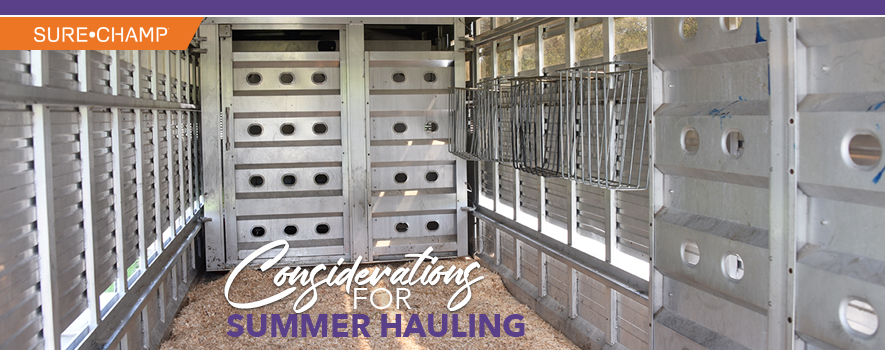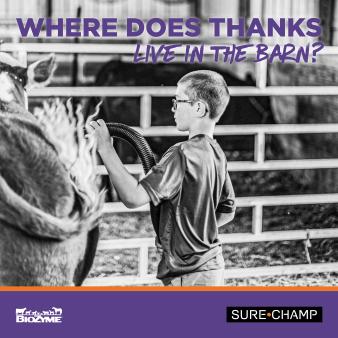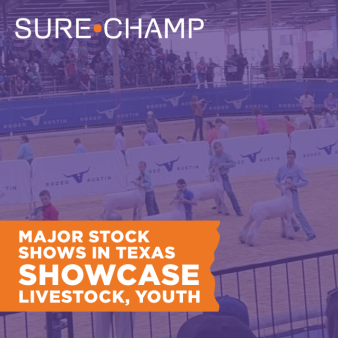
Young livestock exhibitors spend countless hours, days and weeks getting their livestock “dialed in” for summer shows. This year, due to COVID-19, they’ve had a little extra time to work with their animals since numerous late spring shows have been cancelled. As some states begin to open up, while others remain closed, exhibitors are hauling further than ever to get the opportunity to show their animal in a live show.
You’ve grown and worked hair, kept them fresh in their condition and have them show broke like a dream. Now, you just have to haul them as summer heats up and hope that they handle the trip and get to the show looking their best. That can be challenging when you are going a few hours across the state to a preview show. However, with many restrictions still in place in certain states, young people are traveling further, even across several states and time zones to get to get their animals out of the barn and in the ring to jackpots, with hopes to eventually get to a breed junior national.
Making plans with a reliable weather app, allowing plenty of time, following some basic animal husbandry practices and keeping animals on a schedule are four of the most important considerations to keeping your livestock healthy and handling travel in summer heat, according to Jeanene Dal Porto, co-owner of Dal Porto Livestock at Oakley, California, who has traveled the U.S. with son, Dawson, to numerous National Junior Angus Shows.
“It’s all pretty simple. If you’re hot, they are hot. If you are miserable, they are miserable. You have spent all this time and work at home in the barn, doing whatever it is needed to prepare for this show, and you need to continue with that on the road. Don’t quit just because you pulled out of the driveway,” Dal Porto said. “You can give yourself a break when you pull back into the driveway when you get home, but you’ve spent all that time, blood, sweat, tears, love, everything you did and it doesn’t quit because you’re on the trailer heading to the show. That’s when it gets real. That’s when the real work starts.”
Keeping Cool
The most important task of hauling your animal to its summer show destination is to ensure it stays healthy and safe. That means keeping it cool and hydrated. Dal Porto said she checks the weather along her family’s planned route, and if temperatures seem too excessive, they make plans to travel at night once the sun has set and the temperatures have dropped. She also makes sure no adverse weather like tornadoes or severe thunderstorms are in their immediate path, and always has an alternate route, and plenty of layover options just in case.
In addition to traveling during the cooler parts of the evening, take advantage of your trailer’s cooling system. Be sure that any ventilation you have is open, working and not blocked. It is best to have front and rear vents open to maximize air flow. If your trailer is equipped with an air conditioner, use it. You should have your A/C serviced prior to traveling to ensure it is in working condition prior to the hot travel days.
While proper ventilation is of upmost important, so is keeping you animals hydrated. Be sure to have water buckets easily accessible. If you are hauling water from home, make sure to have that water readily available so when you do stop, you can easily water your animals.
“A lot of truck stops have water and most show-broke cattle will see that bucket and drink. They know if they see that bucket, they better drink because it might be a while before their next stop. We always give time; that’s the crucial thing. I don’t usually like to do more than a 10 hours day on the trailer, and that is stopping for a water break if need be. If it’s not too hot, they can go 10 hours without water. Remember this is what works for us,” she said
Back to the Basics
No matter what species you are hauling during the summer, it is always good to keep some basic animal husbandry in mind. Don’t overcrowd your trailer. And if you are hauling a smaller animal like a pig, goat or lamb that is accustomed to its own pen, pen the animal that way on the trailer to avoid any fighting that might cause injury while traveling.
Another consideration is bedding. You want to keep your livestock as comfortable as possible on their trip, without slipping and falling. Be sure to provide them with good, slip-proof bedding for the haul. Shavings or wood chips are a good option as well as a rubber mat. Remember, shavings will help absorb any animal waste, and help keep your animals clean.
Before you leave, make sure you have checked your truck and trailer for any maintenance issues. Are the tires properly inflated? Lights connected and working? Trailer doors all closed and secured? These might seem like simple reminders, but when in a hurry to leave, it is often the simple things that are overlooked.
Layovers on the Long Haul
Dal Porto likes to plan around the length of time it takes to travel to the show, allow for plenty of time for stops and only keep the cattle on the trailer for about 10 hours a day. She credits their show cattle herdsman, Hadley Pitts, for helping plan their route and making sure they have adequate layovers along their course. Pitts is a big part of getting the cattle ready, and he also checks in with them as they travel to their show destination to make sure the people and the cattle are safe. Dal Porto likes to get to a show about four to five days early to let them acclimate to the weather, especially the humidity, which they are not used to in Northern California.
One of the things she appreciates about traveling through the Midwest is the accessibility and set-up of many fairgrounds they have laid over at during their travels. She said most will allow them to pull in, unload, rinse and feed and have the facilities to do so. She has also had extended layovers at fellow breeders like Hoffman’s in Nebraska and Prairie View Farm in Illinois, which also have the facilities to share.
“When we get to a layover stop, we get them off, let them drink, eat, rinse, get them under fans and let them relax. They need to be kept comfortable and they need their routine,” Dal Porto said.
In addition to following weather patterns, planning a route and laying over along the way, Dal Porto said common sense and basic animal husbandry should be followed when hauling animals during summer heat. Allow plenty of room in the trailer. Leave all the side vents and roof vents open for ventilation and make sure nothing is blocking the flow of good circulation. Stop often and check on the animals. Carry Vita Charge® Climate Control Gel with you to help them stay cool and continue eating and drinking.
Vita Charge Climate Control is designed for all species and contains Capsaicin to help maintain the animals body temperature in times of extreme heat and changes in environment. In addition, it contains Amaferm® is a prebiotic designed to enhance digestibility by amplifying the nutrient supply for maximum performance. It is research-proven to increase intake, digestion and absorption.
“There’s nothing better than windshield time with your kid. That is part of making memories with your kid,” Dal Porto said.
Summer shows might have been put on hold, but now that you can finally travel to some, make sure that your animals are traveling safely and comfortably. The hours in the barn and the hours on the road are all worth the memories made when you get to your summer show destination. And prep to win EVERY. DAY. with products from Sure Champ.

